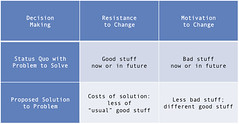
Featured post
What Do High Growth Businesses Do Differently?
Over the past 5 years the importance of the “High Growth Business” and how this relatively small group of businesses disproportionally impa...
Monday, 20 December 2010
Are You Worried That Your Business Will Fail?

Monday, 15 November 2010
Why Web 3.0 Marketing Isn’t the Silver Bullet
 Image via Wikipedia Image via Wikipedia |
| You cant get to the top using the wrong tools |
Thursday, 4 November 2010
Taking Your Business to the Gym – Resolving Decision Overload
 Image via Wikipedia
Image via Wikipedia Image by West Virginia Blue via FlickrThis simple act of delegation and management can be enormously liberating. I can quote a number of occasions where just applying this process has transformed the performance of small businesses. It has freed the owner from almost unbearable stress and allowed him to concentrate on issues more deserving of his attention and transformed employee from mere jobsworths’ to committed and hugely valuable assets.
Image by West Virginia Blue via FlickrThis simple act of delegation and management can be enormously liberating. I can quote a number of occasions where just applying this process has transformed the performance of small businesses. It has freed the owner from almost unbearable stress and allowed him to concentrate on issues more deserving of his attention and transformed employee from mere jobsworths’ to committed and hugely valuable assets.Thursday, 21 October 2010
How to Build a Sustainable Sales Process—without a Rock Star
 Image via WikipediaPundits are calling it “sales 2.0” or “the new world of sales.” Whatever you call it, the story line is the same—Elvis is dead. If you are going to make bigger sales to bigger customers, a rock star salesperson is not the way to go.
Image via WikipediaPundits are calling it “sales 2.0” or “the new world of sales.” Whatever you call it, the story line is the same—Elvis is dead. If you are going to make bigger sales to bigger customers, a rock star salesperson is not the way to go.- · Big companies (we call them “whales”) are afraid to do business with small companies. They are afraid you can’t deliver, that you will run out of capital, that you don’t understand how big companies work, and that your operations and customer service teams are just not sophisticated enough. No matter how much they want your innovative solution, they won’t buy it unless you alleviate all of those fears. And your sales person can’t do that! It will require participation of key subject matter experts, deeply involved in the sales process.
- · The buyers in big companies (end users or purchasing agents) will never lose their jobs over a conventional choice of vendor. But they can definitely lose their jobs if they award a big contract to an unknown provider and the project tanks. You will have to win them over with the strength—breadth and depth—of your team.
- · The corporate environment is getting much more stringent about the nature of relationships between their buyers and all sellers. They want to increase the distance between buyers and sellers and reduce familiarity. They want to avoid even the appearance of collusion or any improper value exchange. Your rock star salesperson, charismatic hail-fellow-well-met, is likely to have serious difficulty in making this transition.
 The “harvest” stage becomes important after you land a big account, but you can’t wait until them to implement best practices for bringing a new account on board. Be sure your team is as ready to deliver the services as it is to make the sale.
The “harvest” stage becomes important after you land a big account, but you can’t wait until them to implement best practices for bringing a new account on board. Be sure your team is as ready to deliver the services as it is to make the sale.
Wednesday, 13 October 2010
Taking Your Business to the Gym – Recognising Decision Overload
Exigent Consulting specialises in providing Business Turnaround, Sales, Marketing and Mentoring to the Small and Medium Business. We help Business Owners improve the profit performance of their business.
Saturday, 25 September 2010
How to Build a Structured Sales Pipeline
Exigent Consulting specialises in providing Business Turnaround, Sales, Marketing and Mentoring to the Small and Medium Business. We help Business Owners improve the profit performance of their business.
Monday, 13 September 2010
Developing a structured approach to sales pipelines - The Issues
A subsequent article will give you a simple format in which to achieve all this so making your sales function more effective
Exigent Consulting specialises in providing Business Turnaround, Sales, Marketing and Mentoring to the Small and Medium Business. We help Business Owners improve the profit performance of their business.
Wednesday, 18 August 2010
Are you Working for a Madman?

Monday, 2 August 2010
8 Steps To Successfully Dealing with Negative Online Reviews
3. Stopped getting emotional? Yes? Its only at this point you should consider responding as by this point you'll be able to view the review objectively and reply in the same manner.
4. Draft your response and review it properly to make sure it addresses their concerns and also that it can't be mis-construed.
5. Get someone else to review it. Only ask a member of staff if you are confident that they will be strong enough criticise your response if they don't think its appropriate. Otherwise ask someone not connected with your business.
6 . Only now its been reviewed should you submit your response
7. Since review sites are set up like blogs, that is with the latest response first, try to get some of your friends to add positive comments to counter balance the negative reviews.
Thursday, 15 July 2010
Taking Your Business to the Gym: The 4 ways to Grow Your Business
- Acquire another company
- Find new customers to buy from you
- Get existing clients to spend more at each visit
- Get existing customers to visit more frequently and spend money
Exigent Consulting specialises in providing Business Turnaround, Sales, Marketing and Mentoring to the Small and Medium Business. We help Business Owners improve the profit performance of their business.
Sunday, 4 July 2010
Manage For Growth or Profit Not Both
Tuesday, 15 June 2010
Inappropriate Use of the Fword
Thursday, 10 June 2010
UK Grant Cuts - First Evidence Emerges
The first real clarity on the Impact of the Cuts on Grants has emerged from the South West RDA as below:
In summary Grants will be cut by 20%; and operating costs trimmed back by 10%;
England's RDA network (outside of London) has been asked to make savings of £270 million in their investment programmes in this financial year, as part of the coalition Government's priority of cutting the budget deficit and reforming public services.
That cut amounts to about 20 per cent of the network's programme budget for the year. In addition, the RDAs will also have to make further savings of at least 10 per cent from our running costs this year.
How those savings will affect individual regions is still under consideration, but for South West England this will mean at least a £23 million reduction in the money available for projects in the region. This will inevitably impact on businesses and communities.
All the RDAs are currently reviewing their funding commitments and will be discussing the implications and the next steps with BIS (the Department for Business, Skills and Innovation). Recent comments from the Secretary of State for Business - Vince Cable - indicate that the level of cuts will be deeper in the South and East of England, which is likely to include the South West, as the North and West Midlands are to be 'relatively protected' from the cuts this year.
Jane Henderson, chief executive of the South West RDA, has pledged that the RDA will make the strongest possible case for protecting key investments and levels of support in the region.
Content was kindly provided by Bob Watson at www.support2business.co.uk
Should you want to ask questions about any Grant Assistance, please drop me an email at laurence@exigent-uk.com
Tuesday, 11 May 2010
Survey: How Much Time We Spend Social Networking Each Week
Friday, 26 March 2010
The Lasting Effects of Quality
I wanted to use two stories the show how different views towards providing quality product or service can leave a lasting impression on your customers.
Some five years ago we bought a settee from Laura Ashley. It was quite expensive for us but we liked the design so we bought it. The company also offered a five year guarantee. After nearly five years one of the legs of the settee failed. We phoned up Laura Ashley who promptly set out their customer service representative to look at the situation. On her arrival she had agreed without hesitation that yes indeed the settee was faulty and she would have arranged to have it replaced. Cheekily I asked if he would be possible to change the material on the replacement setting since the old material clashed with our new decor and didn't appear to wear that well. The customer service lady said that wouldn't be a problem and we would only have to pay for the difference in grading of the new material as compared to the old material. Eight weeks later our new settee arrived. Since then, and whenever we can afford it we buy Laura Ashley products.
By contrast when we first got married we went to a very friendly and cheaply priced furniture store called Cantors; which by the way, sadly no longer exists. We bought a lovely settee at a cheaper price. The company arranged to deliver it within six weeks. We were duly informed it was ready for delivering, about 3.30 PM I've got a distressed call from my wife yes the settee have been delivered but it was quite big and the delivery men had struggled to get it into a hall. At which point they said the settee had been "delivered" and promptly left, effectively blocking the front door as an exit to the house. So on my return from work I spent an hour or so struggling to get the settee from the hall into the lounge and set up. We did love that settee, but we never did buy anything else from Cantors again.
The moral of this story, is of course, that you get what you pay for. The reason why Laura Ashley could offer such a high quality service was because they had included it in the price of their product. It should be clear from this that as a business owner you can either provide limited customer service for a cheap price, or an excellent service at a high price. What you can't do is to provide an excellent service at a cheap price.



